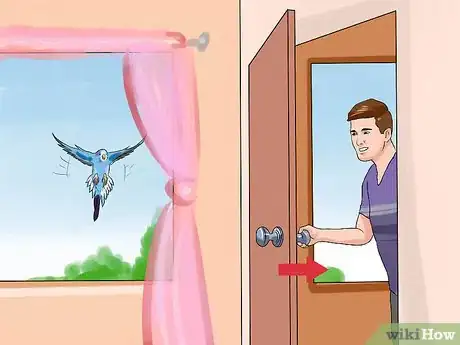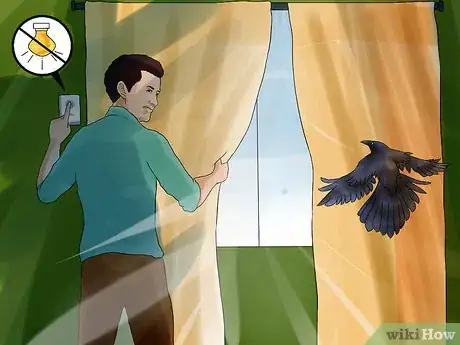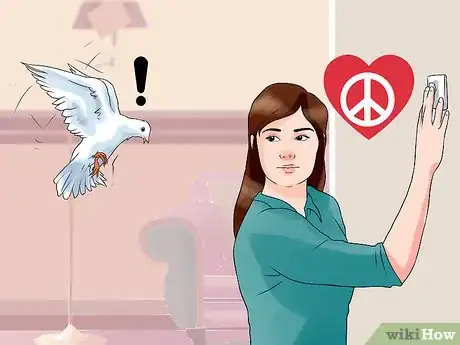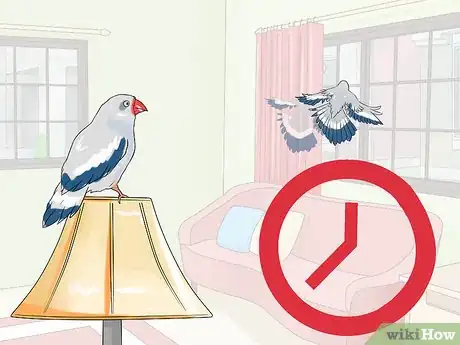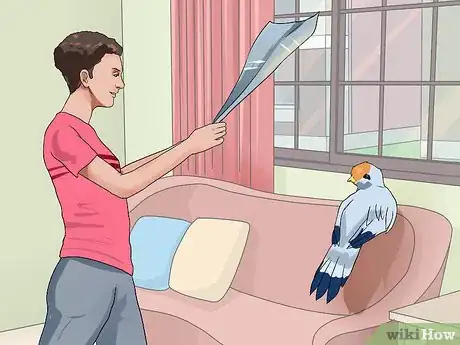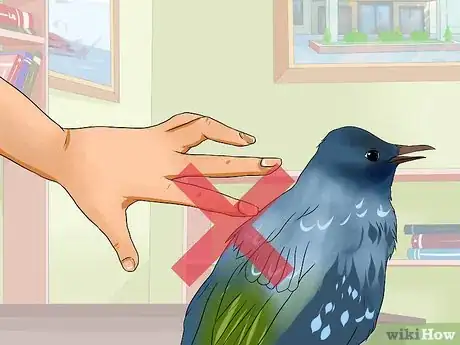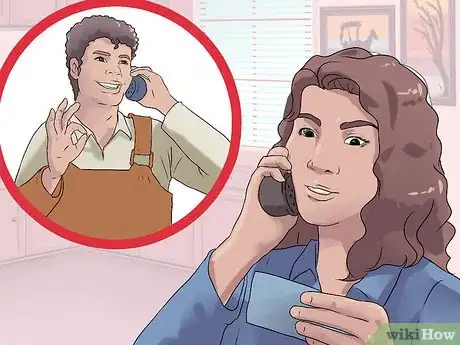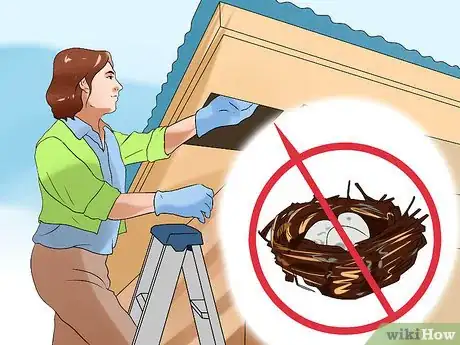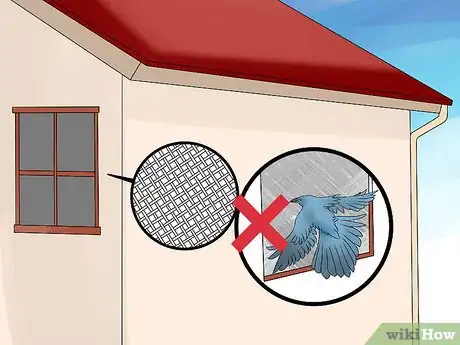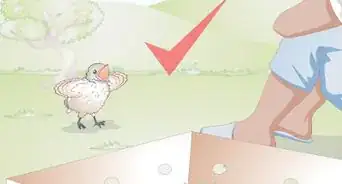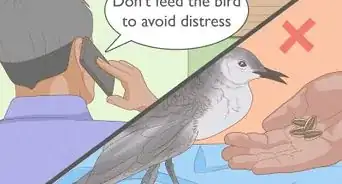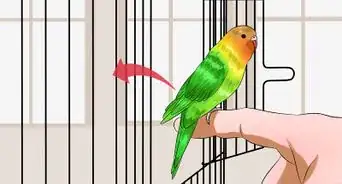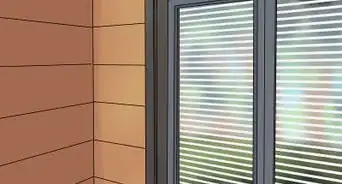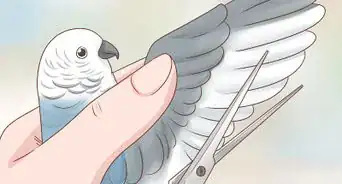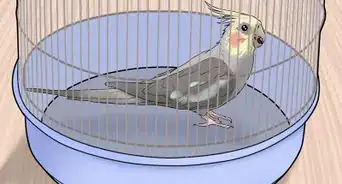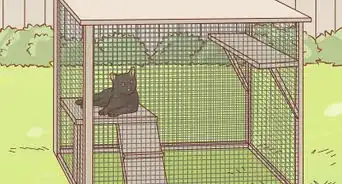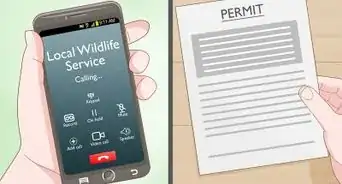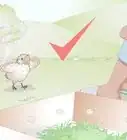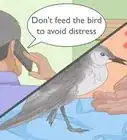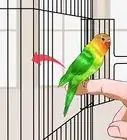This article was co-authored by Roger J. Lederer, PhD. Dr. Roger Lederer is an Ornithologist and the founder of Ornithology.com, an informative website about wild birds. Dr. Lederer has spent over 40 years teaching, studying, and writing about birds. He has traveled to over 100 countries to study birds. Dr. Lederer is an Emeritus Professor of Biological Sciences at California State University, Chico, and has been a Department Chair of Biological Sciences and Dean of the College of Natural Sciences. He has written more than 30 research papers and 10 books on birds and a textbook entitled “Ecology and Field Biology.” Dr. Lederer has consulted the BBC, National Geographic, National Public Radio, ABC News, the Guinness Book of World Records, and numerous other organizations and publications.
This article has been viewed 174,547 times.
Having a bird trapped inside your house can make you feel like you are stuck in an Alfred Hitchcock film. Maybe you have just arrived home and you hear an odd rustling sound in the corner of your living room. Or perhaps you walk onto your screened porch to find a panicked, flailing bird hurling its body into the walls. This article will help you keep your cool in this scenario so you and the bird can safely get on with your day.
Steps
Containing the Area
-
1Close off any doors to the room that lead to another area of the house. When the bird sees you enter the space, it will be tempted to move away as quickly as it can, even if that means flying deeper into your home. Close all doors to the room so the bird cannot fly into all corners of your house. It will also be easier for the bird to find an exit once it realizes it can't leave that particular room.[1] .
- If the bird is in a room that does not have a clear exit, then hold up a large sheet with both arms and attempt to herd the bird into a better room of the house. Do not touch the bird with a broom or any other long-handled object.
-
2Remove any household pets (especially cats and dogs) from the room. This will certainly disappoint your cat, but having additional animals in the room will only increase the bird's level of panic. You also don't want to risk the spread of disease to your household pet should they attack the bird.Advertisement
-
3Create a single light source near the exit. Close all window curtains and turn off all lights except where you want the bird to exit (such as an open door or window). The bird will naturally avoid darkened spaces and will treat the light near the exit as a beacon to guide it out.[2]
-
4Remain calm. The bird might seem very intimidating to you; if it is panicked and beating its wings while flying in an erratic fashion, you might be tempted to yell, scream or immediately strike it. But this will only increase the bird's fear and potential damage to your home. Remember that you are in your natural habitat whereas the bird is scared and disoriented. Remain calm while you close off additional lights and entrances to the room.
Removing the Bird from Your Home
-
1Create a clear exit for the bird. Depending on the room the bird is trapped in, you should select the easiest, largest exit available for the bird. This might be the largest window or, ideally, a door that leads to the outside. It will easiest if you just select one clear exit so the bird will notice it from the light.
-
2Leave it alone. Once you have sealed off the doors to the room, turned off additional lights, and have clearly opened a door or window so it can exit, leave it alone. There is a good chance the bird will eventually fly out on its own. Birds are very sensitive creatures and they can die due to complications from stress; the least traumatic solution for the bird is to let it attempt to leave on its own.[3]
-
3Coax it out. If the bird has not left on its own, you can attempt to 'herd' it toward the exit. Take a large sheet and hold it up with both hands; slowly walk behind the bird, steering it toward the exit so it can fly outside.
-
4Do not touch or harm the bird. Some sources suggest that you should throw a towel or sheet on top of the bird to ground it and then pick it up and manually remove it from your home. This method, however, should be avoided except as an absolute last resort, as this could easily injure the bird, even if we can't tell that it is hurt.[4]
- Birds are biologically designed to be sensitive to pressure; they can feel very subtle changes in air pressure, so being engulfed by a large towel or sheet can be incredibly painful to them. Their bones are also very fragile so even a gentle human touch could cause significant injury to the bird
- Do not use a broom or other object to hit the bird; this will only injure the bird and further prevent it from flying back outside.
-
5Call a professional. If you have tried all of these steps and still cannot successfully remove the bird, then you should call a local professional who works in bird removal. They will have a better sense of the bird's behaviors and the best way to remove it safely from your home.
Preventing Your Home from Future Bird Visitors
-
1Inspect your home for possible points of entry. Sometimes, a bird will simply fly into your home through an open door or window by mistake; there will be very little you can do to prevent this from happening. But you should still consider adding sturdier screens onto your windows and avoid keeping large entrance ways (like sliding glass doors) open to the outside.
-
2Stop a potential nesting crisis in your home. When a bird randomly flies into your home, you can view that as just a single, strange incident; but having a nest of pigeons or other birds move into your attic is another crisis that requires a very different approach. Birds that like to nest in homes tend to prefer areas such as chimneys, gutters, eaves, and laundry vents; you should make sure that these areas are properly sealed so they cannot enter your home.[5]
- If you have a woodpecker who continues to bore into the side of your house, hang a shiny object -- like an old CD or DVD -- near the site; this will deter the bird from remaining in that spot. Wind chimes are also helpful in discouraging woodpeckers.[6] Hanging a piece of mylar tape and letting it dangle can help as well.
-
3Contact a professional for help in deterring birds. Many wildlife removal experts specialize in using objects that will prevent birds from nesting on or in your home, such as bird spikes, avian sound machines, tape, glass and other materials. If you sense that birds could become a problem for your home, go ahead and contact a professional to help you prevent this from happening.
Community Q&A
-
QuestionHow can I locate a bird that has flown into my house?
 Community AnswerBe absolutely quiet. The bird is probably scared and will make noise. Listen for it.
Community AnswerBe absolutely quiet. The bird is probably scared and will make noise. Listen for it. -
QuestionA bird got stuck in my backyard and can't fly. What can I do to help?
 Community AnswerTake it to an animal rehabilitation center, if possible. If not, call them so they can give you step-by-step instructions.
Community AnswerTake it to an animal rehabilitation center, if possible. If not, call them so they can give you step-by-step instructions. -
QuestionI have 4 birds stuck in a high up window on my porch. I was told that when it got dark they would figure out how to get back out, but they have been there for 2 days. What do I do?
 Community AnswerCall your local wildlife organization and explain your situation. They can help you.
Community AnswerCall your local wildlife organization and explain your situation. They can help you.
References
- ↑ http://www.wildlife-removal.com/birdinhouse.html
- ↑ http://www.mnn.com/earth-matters/animals/stories/how-to-get-a-bird-out-of-your-house
- ↑ http://www.wildlife-removal.com/birdinhouse.html
- ↑ http://www.mnn.com/earth-matters/animals/stories/how-to-get-a-bird-out-of-your-house
- ↑ https://www.rspb.org.uk/birds-and-wildlife/advice/wildlife-and-the-law/birds-in-the-roof/how-to-stop-birds-nesting-in-roofs/
- ↑ http://wildliferescue.ca/wildlife-hospital/faq/
About This Article
To chase a bird out of your house, start by closing all of the doors in the room so the bird doesn't fly into a different part of your house. Then, open a single window or door that leads to the outside so the bird has a clear exit. You should also turn off the lights and close any curtains in the room so the bird is drawn to the light coming from the open window or door. If the bird doesn't leave on its own, try holding up a large sheet and walking toward it so it flies out the exit. To learn how to prevent birds from getting into your home, scroll down!
